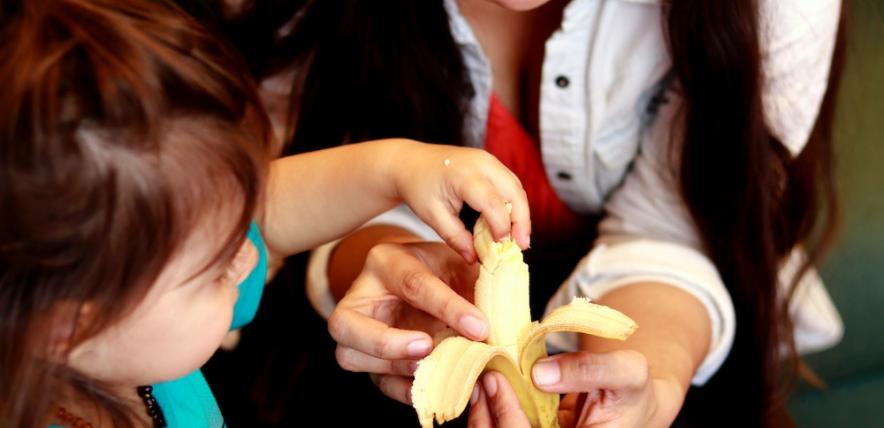By Annie Denny, Nutrition Development Manager.
We all know that children (and adults) should eat at least five portions of a variety of fruit and vegetables a day.
However, it’s not easy to know how much a child’s portion should be, given that children’s portion sizes vary with age, body size and levels of physical activity.
Research tells us there is a link between eating plenty of vegetables and fruit with lower levels of heart disease, stroke, cancer and early death later in adult life.
Both the quantities and variety of vegetables and fruits consumed are important.
The more that’s consumed, the lower a person’s risk of disease.
Eating the rainbow
Encouraging children to “eat a rainbow” of vegetables and fruits is important, as different colours and varieties of veg and fruit provide different nutrients and antioxidants.
Dark green leafy veg such as cabbage, spinach, kale, brussels sprouts and bok choi are excellent sources of health-promoting chemicals called “bioactives” (which give these foods their greenish-purple colours), but children can find these vegetables bitter.
That’s why it’s important to expose babies to a wide variety of vegetables during weaning, and then keep up their exposure to different vegetables throughout childhood, as adult food preferences are formed during childhood.
Having fun with food
Be cautious not to reinforce the idea that vegetables are unpleasant and need to be hidden within other foods.
Encourage children to have fun together trying lots of different fruit and veg, promoting the idea of “visible veg”, rather than hidden veg.
Getting children involved in choosing and preparing fruit and vegetables can encourage them to eat more.
What counts as part of 5-A-Day?
Don’t forget that vegetables and fruit don't have to be fresh to count as a children’s portion; frozen, tinned (in natural juice or water, with no added sugar or salt), dried and those cooked in dishes such as soups, stews or pasta, as well as ready meals and shop-bought soups, all count.
Often frozen vegetables and fruits are more nutritious than fresh ones, as freezing preserves the nutrients.
Pulses and beans (40g), including baked beans, can count as one portion of a child’s 5-A-Day, but no more than one, even if more is eaten. This is because although they're a good source of fibre, they contain fewer nutrients than other fruits and vegetables.
A 15g portion of dried fruit, such as currants, dates, sultanas and figs, counts as 1 of a child’s 5-A-Day, but should be eaten at mealtimes, not as a between-meal snack, to help protect teeth.
Fruit juice should be avoided, to limit tooth decay but if you do offer it, it should always be diluted (one part juice to 10 parts water) and only offered at meal times.
Drinks that say "juice drink" on the pack are unlikely to count towards a child’s 5-A-Day.
Beware the packaging
It can be hard to make a judgement call on the nutritional value of packaged-processed foods targeted at children, that make a 5-a-day claim on pack (such as crisp/savoury snack type products, or fruit gum/fruit flake -based snacks).
One of the key reasons for eating 5-or-more portions of fruit and veg per day is the fibre, vitamins and minerals that fresh, frozen and canned fruit and veg provide.
Some pre-packaged snack foods targeted at young children don’t provide an equivalent amount.
Snacking on a piece of fruit is usually a cheaper and more nutritious option.
If you offer these packaged foods they should be alongside fresh, frozen and canned fruit and vegetables — not in place of them.
A guide to portion sizes
There is no official guidance on what constitutes a child size portion, but experts agree that around half an adult’s portion is realistic, so 40g for 1- 4 year olds.
Between the ages of 1 and 4, a useful guide is the amount a child can fit in the palm of their hand.
For children under 1, the 5 a day guidance doesn't apply as, although vegetables and fruits are packed full of vitamins, minerals and antioxidants, they are low in energy (and babies have very high energy requirements combined with small stomachs).
The table below shows some example portion sizes of different vegetables and fruits for young children.
Portion sizes should increase as the child gets older, so that by adolescence an adult portion is consumed. For adult portion sizes download this portion guide.
Five top 5-A-Day tips
- Veg isn’t just for dinner – squish canned tomatoes over toast, add frozen spinach or canned mushrooms to scrambled eggs or cook up a weekend vegetable breakfast hash.
- Give fresh vegetables or fruit e.g carrot sticks for your child's after-nursery snack on the way home. When children are really hungry they can be more likely to try foods they might otherwise refuse!
- Try not to ‘hide’ vegetables, but you bumph up stews, casseroles and Bolognese with grated veg such as carrot, courgette, butternut squash or cabbage. A 500g bag of frozen mixed veg costs £1 and can be added by the mugful to stews, shepherd’s pie, pasta bakes/salad, meat pies, curries and chicken cooked in jarred sauces.
- Keep the fruit bowl in the living room rather than the kitchen. For older children, hide the remote control under the fruit!
- Create a rainbow or a letter chart and try one fruit or vegetable for each colour or letter.
| examples of suggested choices | range of portion sizes |
|---|---|
Fresh fruit |
1/4 - 1 banana 1/2 - 2 tablespoons of avocado 1/4 - 1/2 apple 1/2 - 1 satsuma 1/4 - 3/4 pear 3 - 10 small grapes (halved), berries 1/2 - 1 kiwi, plum, apricot 1/4 - 1 peach, nectarine 1/4 - 1/2 orange, mango 1/4 - 1 thin slice of melon
|
Dried fruit(only at mealtimes, not as a snack) |
1 - 4 whole apricots, prunes, dates, figs 1/2- 2 tablespoons of raisins, sultanas |
Stewed fruit(no added sugars, honey, syrups) Canned fruit(in natural juice, juice drained) |
2 - 4 tablespoons
2 - 4 tablespoons |
Vegetables |
1/2 - 2 tablespoons of bamboo shoots, beetroot, broccoli, cauliflower, courgettes, squash, okra, aubergine, green beans, leeks, onions, mixed vegetables, parsnip, peas, spinach, kale, swede, sweetcorn 1 - 3 tablespoons of cabbage, cooked carrot 1/2 - Brussel sprouts (halved) 2 - 6 sticks of raw carrots 2 - 8 small sticks of celery, cucumber, peppers, mange tout 1 - 4 cherry tomatoes (halved) 1 - 2 small leaves of lettuce 1 - 4 button mushrooms (sliced) |







